Every year, the STIB plans a number of major summer construction sites. These projects cause disruptions on our network for an extended period of time. In this blog post, we explain what’s at stake with these works and why they are carried out during the summer.
Traffic, disruption and weather conditions
The main question we often get is: why do we carry out major works during the summer holidays?
To minimize the impact on traffic and inconvenience for residents, these works mostly take place during the summer holidays. First and foremost, because of the weather: less rain + no frost + more sunshine = better working conditions.
It’s also a much calmer period, which means that fewer passengers are affected by our service interruptions. Road traffic is lighter too, as is the use of our network. That makes it easier to close streets and organize detours. Many residents are also away on holiday, so fewer people are directly impacted.
During the summer holiday, we also have more vehicles available, as we operate a summer timetable. We can use these vehicles to provide shuttle services, which is much harder to do during the rest of the year, when almost our entire fleet is in service.
Moreover, the summer holidays are the only period of two consecutive months that allow us to work under these favorable conditions.
Summer works: more comfort for our passengers
We have around 292 km of tram tracks (activity reports 2022), which need to be replaced approximately every 25 to 30 years. In some areas — for instance in curves where wheel friction is higher — the tracks need to be replaced sooner.
Even though we understand that disruptions are inconvenient, these renewals are absolutely essential for your safety and comfort. Worn tracks cause tram wheels to deteriorate faster, leading to more noise and higher maintenance costs. Moreover, worn tracks often require speed limits, which can reduce service frequency. Therefore, to ensure a reliable and safe service, we must replace the tracks on time.
According to our multi-year planning, we should renew 11 kilometers of tracks per year, but in practice, obtaining all necessary permits is not always possible. As a result, we actually replace an average of 9 kilometers per year. However, our network urgently needs these renewals: the number of trams is increasing, and they are larger and heavier, which causes faster wear of the tracks.
That’s why the STIB has decided to increase the renewal pace from 11 to 15 kilometers per year. In addition, we now plan works 10 years ahead instead of 5, to better anticipate permit applications. Our annual budget for track renewals amounts to 50 million euros.
At the same time, we’re carrying out more preventive maintenance, such as visual inspections, rail lubrication and grinding.
Anti-vibration mat
When renewing tracks, we also seize the opportunity to install an anti-vibration mat. The rails are encased in rubber and placed on a concrete slab, which itself rests on a rubber mat. This rubber partly consists of recycled tires from our own buses! This anti-vibration mat helps improve the daily lives of nearby residents, who will experience significantly less vibrations from passing trams.
For every worksite, we also assess if we can make stops more accessible. In some cases, Brussels Mobility takes advantage of the works to redesign the entire public space, from façade to façade.


Informing and assisting
Comme pour chaque chantier, la STIB vous accompagne. Des agents sur place vous aideront dans votre With every worksite, we make sure to inform and assist you. Staff are present on-site to guide you, our journey planner shows the detours, and we provide shuttle buses as well as information through leaflets, posters, and info boards. Visit our website for more details.
And of course, you can reach us through social media or by phone if you have any questions — we’ll be happy to help!
All information about our works and updates on disruptions are available on our website. Need an alternative for your journey during the works? With Floya, you can easily combine all transport modes in Brussels, from shared cars to bikes and scooters. Learn more on Floya’s website and blog.


